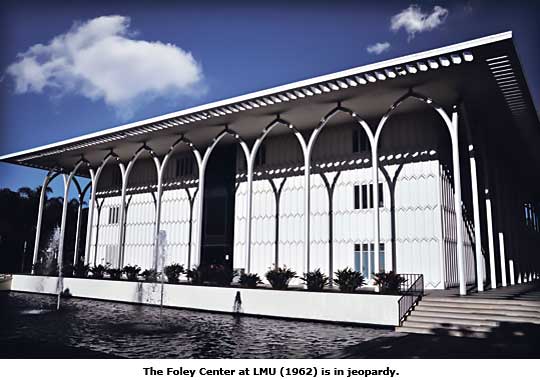Pandora's Box Of '60s Architecture - Page 2

5. The Conservancy is both ahead of, and behind, the curve. The Conservancy heard from other preservation organizations around the region and the nation that they had not yet begun to grapple with their '60s architectural heritage. After all, it was only in 1962 that the City of Los Angeles created a landmark program to protect historic structures, and it was another four years before the National Historic Preservation Act was passed. The exception was a New York organization that embraced the '60s a decade ago.
6. There is so much more to do. One of the Conservancy's goals in this program was to address the technical and philosophical challenges of preserving 1960s architecture, from the importance of historic integrity when using mass-produced materials to enhancing the energy efficiency of buildings designed at the dawn of air conditioning. The Conservancy raised more questions than answers, but they were not alone. Preservationists around the country are discussing these and other issues, and the Conservancy is eager to be part of the conversation.
The effort to preserve the 1966 Century Plaza Hotel (see sidebar story) did help to clarify one important issue. The process of determining how to preserve the hotel building as part of a mixed-use development has yielded groundbreaking treatment protocols for aluminum, which has a typical life span of only 40 years. These guidelines for repairing, restoring, and replacing historic aluminum can serve not only the Century Plaza but countless other buildings from the '60s and beyond.
Ultimately, the Conservancy's efforts underscore the amount of work that remains to be done, in terms of both education and advocacy. During the span of the program, they experienced the thrill of victory with the Century Plaza Hotel and the agony of defeat with the Columbia Savings Building (see sidebar story here). Other '60s buildings remain in jeopardy, such as the Edward T. Foley Center (Edward Durell Stone, 1962) at Loyola Marymount University.
As the Los Angeles Conservancy fights to save 1960s architectural gems from the wrecking ball, they now have the benefit of a strong context and growing constituency for their preservation. The Conservancy is teaching themselves as they educate others and stretch the boundaries of 'traditional' preservation. Oh, and having a bit of fun along the way.
• Trudi Sandmeier is director of education for the Los Angeles Conservancy. Cindy Olnick is the Conservancy's director of communications. Learn more about the L.A. Conservancy at laconservancy.org.




